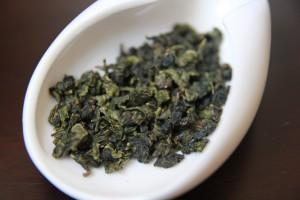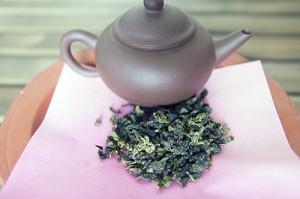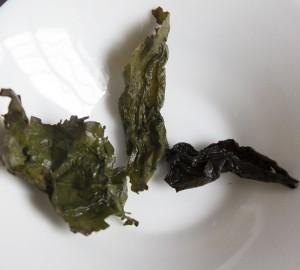If you ask casual tea drinkers to name one Chinese tea, probably one of the first non-green teas to turn up is Tieguanyin aka Iron Goddess of Mercy or erroneously translated as Iron Buddha.
If you asked them to describe their opinion or experiences with it though, you can have quite a variety of answers.
It could be a variation in the grade ranging from “restaurant grade teas” to “gift for your most valued business associate or mother-in-law”.
This is quite common among Chinese teas, for certain varieties, you can have a difference in pricing ranging up to 50-100 times for commercially available grades, i.e. non-competition grade teas.
However for Tieguanyin, the variance goes beyond grades.
The main styles are ‘green style’ (清香), traditional style (浓香) and charcoal roasted (碳焙).
Even within the last 2, there can be quite some variation in the level of roasting which can give a liquor color that ranges from golden to brown.
The main differences in terms of taste are that the ‘green’ version is lighter and more fragrant than the traditional versions which have a more full-bodied mouth feel.
The Rise of the Green

Many farmers in Anxi starting incorporating the High Mountain Teas production technique into their local cultivars such as Tieguanyin , Huang Jin Gui and the other Sezhongs.
It became popular for the following reasons:
Accessible for Beginners
For those who are new to tea, the ‘green style’ represented an accessible entry point. Fragrant and refreshingly light, it became popular with a nation that was predominantly dominated by green tea.
In addition, for new tea drinkers who focus only on aroma and flavor, this was easily appreciated.
A whole new generation of tea drinkers incorporated oolong tea into their lives because of the green style Tieguanyin.
Accessible for Producers
Traditional oolong tea production is arguably the most demanding of all. With a high level of experience and discretion required for the ‘zuoqing’ and roasting stages especially, it is not easily learned and replicated for new producers.
This partially explains why outside of Fujian, Guangdong and Taiwan, production of oolong tea is limited.
The ‘green style’ though is simpler. With a low level of oxidation and no roasting, merely light baking to dry the leaves, it is virtually as simple as production of black tea and many new producers hopped on the bandwagon.
This led to a large number of new farm and factories opening up and ‘green style’ Tieguanyin was almost single-handedly responsible for propelling oolong tea into the ‘mainstream’ outside of Southern China and Southern China communities.
Things are a’Changing
In the past couple of years though, things no longer appear so rosy for Tieguanyin.

Far from the darling it was, ‘green’ Tieguanyin became a bit of a dirty word in the industry.
There are a myriad of reasons for its decline in popularity but I think it is mainly attributable to the following:
Too Fast Too Soon
The fame of ‘green’ Tieguanyin soon became its undoing. Many of the newer farmers and producers focused only the economic benefit without paying head to quality control or sustainable farming methods.
In a bid to ramp up production, quality control was eschewed and a proliferation of low quality ‘green’ Tieguanyin flooded the market.
Un-endearing
While it may have been charming initially, few people managed to drink Tieguanyin regularly. The problem was that it hurt the gastric with its extremely ‘cold’ TCM nature.
Much of what is endearing about tea is how it can be a daily comfort and a healthful one at that.
But as tea drinkers discovered, it was hard to drink ‘green’ Tieguanyin regularly without discomfort. Eventually, many of them abandoned the ‘green’.
Return to Tradition
While ‘green’ Tieguanyin makers suffered, traditional Tieguanyin continued to thrive.
In fact a positive by-product of the ‘green wave’ was that the fame of Tieguanyin grew and many of those who experimented with other types of Tieguanyin fell in love with it.
Traditional Tieguanyin makers though were in shorter supply considering the complexity of production and difficulty of it. Hence while prices of ‘green’ Tieguanyin plummeted, prices of traditional Tieguanyin held steady and in fact even rose against the tide, albeit to a lesser extent compared with Yancha.
What of the rest?

It was a natural fit, production of black tea is even simpler than the high mountain teas and there was little teething difficulty.
Coupled with how well suited the Tieguanyin cultivar is for black tea, the Hong Guan Yin seems to be giving a new lease of life to the ‘green’ makers in Anxi.
This serves as an interesting case study for China’s tea industry though- the detriments of over-expansion and lack of quality control.
While innovation is to be embraced, the rationale behind the tradition methods ought to be studied before choosing to eschew them.
Hope this serves as a cautionary tale for the baked dried ‘puer’, non-traditional white teas and other bandwagon hopping teas.
After all, if something has been popular for centuries, doesn’t it make sense to study the rationale behind it?
See here for other articles related to varieties of oolong tea
